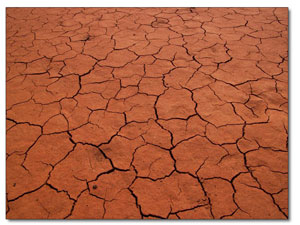|
|
Megadrought, the new normalby Ari LeVaux
But this might be the new normal for the American Southwest, writes William deBuys in his new book, A Great Aridness. It was published late last year, months after one of the Southwest’s driest summers in recorded history, during which fires of unprecedented size scorched hundreds of thousands of acres of forest. This summer is worse than last; forest fires have already broken last year’s records. The rains haven’t come, and temperature records are falling like leaves from a dried-up tree. Springs, wells and irrigation ditches are bone dry. Farms are withering. We’ve all heard the gloomy scenarios of global warming: extreme weather, drought, famine, breakdown of society, destruction of civilization. My current perch in Placitas, N.M., feels like a front-row seat to the apocalypse. Intuitive as the connection may seem, we don’t know if the current drought is a consequence of global warming, deBuys writes. Periodic, decades-long droughts have been relatively common in the last few thousand years, according to analysis of dried lake beds. Most of the area’s famously collapsed civilizations – Chaco Canyon, Mesa Verde, the Galisteo pueblos – are thought to have died out for lack of water in these extended dry periods, which deBuys calls “megadroughts.” By contrast, the last century’s human population growth in the American Southwest occurred during a relatively wet period in the climactic record. We were due for another megadrought sooner or later, deBuys writes, which could be expected to dramatically alter human settlement patterns in the area. While this current heat may not be caused by global warming, he writes, climate change could nonetheless trigger the next megadrought. In the Sandia Mountains above Placitas, last winter’s snowpack was relatively high. But the spring runoff never came, because the snow evaporated straight into the air of the hottest spring on record. Lynn Montgomery has been farming in Placitas for more than 40 years. Like many farmers in northern New Mexico, he irrigates his land with water from an acequia, a type of canal system implemented by Spaniards, who’d adopted the technique from the Moors. This year, for the second year in a row, Montgomery’s acequia has run dry. Last year, summer rains came in time to save his crops, but this year the rains haven’t come. The ditch is dry. His farm is dying. First to go were the young Italian prune trees. His more established pear trees were next. Now, his decades-old grape vines are dropping their fruit and clinging to their lives. The 30-year-old asparagus patch is toast, as are the perennial herbs, garlic and strawberries, along with everything he planted this spring. Even the weeds are dead. The farm was part of a thriving community in the ‘60s and ‘70s. Most of the inhabitants drifted away, or ran away, or got dragged away by the police. Montgomery was the last man standing. He sold the farm to the local Pueblo Indian tribe, on the condition that they assume ownership after his death, and spent the proceeds paying lawyers to enforce water law around Placitas. He managed to stop several developments that would have illegally taxed the fragile aquifer. Despite his successes, which included a victory at the New Mexico Supreme Court, many wells were drilled, especially in the 1980s and 1990s, dropping the water table to the point at which many springs in Placitas began running dry, along with the acequias they feed. Montgomery’s neighbors, with the turn of a tap, can water their grass and wash their cars thanks to the wells that killed the spring that feeds his acequia. But it’s only a matter of time, he told me, until they feel his pain. “At that point all the bedroom community types will realize that the real estate people have bamboozled them, and most of us too,” he said, referring to the Placitas real estate boom of the late 20th century. Tempers are getting short. Trujillo said he was verbally threatened last weekend at Morphy Lake, the reservoir his acequia association helped build. Even if the next megadrought has already begun, deBuys says, we wouldn’t know it yet. “The character of a drought becomes clear only retrospectively.” Either way, he suggests, our decisions for the future should be the same. “Building resilience against drought into the region’s water systems and cultural practices would be a wise course, irrespective of the cause or timing of the next emergency,” he writes. To that end, Lynn Montgomery is scraping together the resources to re-tool his farm to be more efficient with water. He’s installed a holding tank, in which he’ll be able to store precious acequia flow in future years, before it goes dry again. And he’s switching from traditional flood irrigation, the way it’s always been done in Placitas, to more efficient drip tape. It remains to be seen whether his adaptations, and his resilience, will be enough to help him face the new normal. |
In this week's issue...
- May 15, 2025
- End of the trail
Despite tariff pause, Colorado bike company can’t hang on through supply chain chaos
- May 8, 2025
- Shared pain
Dismal trend highlights need to cut usage in Upper Basin, too
- April 24, 2025
- A tale of two bills
Nuclear gets all the hype, but optimizing infrastructure will have bigger impact


